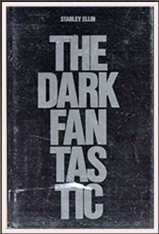Tue 26 Mar 2024
A 1001 Midnights PI Review: STANLEY ELLIN – The Dark Fantastic.
Posted by Steve under 1001 Midnights , Reviews[3] Comments
by Robert E. Briney
STANLEY ELLIN – The Dark Fantastic. John Milano #2. Mysterious Press, hardcover, 1983. Berkley, paperback, 1985.
Stanley Ellin is one of the most honored of contemporary writers of mystery fiction. Beginning with his first story in 1948, he consistently won prizes in the annual short-story contests run by Ellery Queen’s Mystery Magazine. He is a three-time winner of the Edgar Award of the Mystery Writers of America: for Best Short Story in 1954 and 1956 and for Best Novel (The Eighth Circle) in 1958. Four other stories (the most recent in 1983) and one novel have appeared on the short list of nominees for the Edgar. His novel Mirror, Mirror on the Wall ( 1972) was awarded France’s Grand Prix de Littdrature Policifte in 1975.

He was elected president of the Mystery Writers of America in 1969, and in 1981 received that organization’s Grand Master Award honoring his lifetime achievement in the mystery field. The point of this litany of awards is that they are all deserved. As a careful craftsman with an ear for language and a deep concern for its proper use, as an acute observer of the human condition, and as an inventive plotter with a flair for the unexpected, Ellin has maintained a consistent level of quality that makes him indeed a grand master of his art.
A string of awards and a proven track record do not, however, guarantee that publishers will jump to accept a book with potentially controversial elements. The Dark Fantastic was rejected by several major publishing houses before being picked up by a relatively small specialty publisher. It subsequently gathered a stack of favorable reviews in the United States, sold to a major British publisher, and has become a feather in the cap of the Mysterious Press.
The story alternates between two viewpoints: that of Charles Witter Kirwan, a retired college professor with madness eating at his brain just as cancer is eating at his body; and that of John Milano, a private detective first introduced in Star Light, Star Bright (1979), who specializes in the recovery of stolen works of art. Kirwan, reluctant landlord of an apartment building in a black neighborhood in Brooklyn, plans to blow up the building with himself and his black tenants inside. Among the tenants are the family of Christine Bailey, who works as a receptionist in a Manhattan art gallery currently under investigation by Milano.
From this tenuous connection, the paths of Kirwan and Milano are drawn inexorably together. Ultimately, Milano is the only person who has a chance to uncover Kirwan’s plot; but can he stop it in time? Ellin tightens the screws expertly. and the suspense intensifies up to the very end.
Kirwan’s chapters are in the form of transcripts of a tape-recorded journal in which he attempts to explain the reasons for his destructive plan, while recounting the day-to-day progress toward its accomplishment. The transcripts are studded with racial invective-not mere ethnic name-calling, but the type of inventive viciousness that an educated mind can apply to the expression of its prejudices.
These passages make uncomfortable reading, especially in view of the skill with which Ellin takes us into Kirwan’s mind and makes us understand the familial and societal roots of his attitudes. Another source of discomfort for some readers lies in the explicit descriptions of Kirwan’ s sexual victimization of Christine’s teenaged sister.
But Ellin handles this highly charged material with assured skill and without a hint of sensationalism. The book is a serious psychological study, a detective story, an unusual love story, and an exercise in down-to-the-wire suspense: a worthy addition to the author’s already impressive body of work.
———
Reprinted with permission from 1001 Midnights, edited by Bill Pronzini & Marcia Muller and published by The Battered Silicon Dispatch Box, 2007. Copyright © 1986, 2007 by the Pronzini-Muller Family Trust.
March 29th, 2024 at 5:07 am
I was stunned by the book I held in my hand when I randomly happened across ‘Eighth Circle’. No idea how it even came my way. But what a discovery. What a dab hand that guy wields with a brush. One of the most riveting reads I’ve ever enjoyed.
March 29th, 2024 at 11:25 am
As quite an anomaly in his day, not unlike the far more prolific Edward D. Hoch, Ellin was much more known for his short fiction than his novels. THE EIGHTH DAY was one of his better ones, though, no doubt about it.
March 30th, 2024 at 1:22 am
Ellin always seemed to find a different way to tell private eye stories than anyone else from the first Milano all the way to THE BIND.